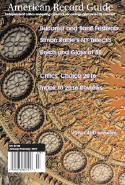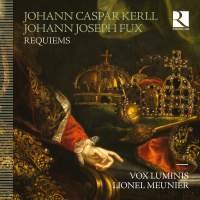Texte paru dans: / Appeared in: |
|
|
Outil de traduction ~ (Très approximatif) |
|
|
Reviewer: Peter
Loewen This recording presents Requiem Masses by two of most distinguished Viennese composers in the generations immediately before Mozart. Of course Johann Kaspar Kerll (1629-93) and Johann Joseph Fux (1660-1741) were fine composers in their own right, but Jerome Lejeune frames his notes to emphasize the precedent these works set for Mozart’s Requiem. In the hands of these astute musicians, it is possible to compare the refinements of each composer. The concerted style is perhaps the most obvious similarity between them. That is, each composer divides the text between tutti and solo ensembles. The orchestra accompanies the voices, but the instruments sometimes also get involved in the drama of the text. For example, the alto trombone in Fux’s setting of ‘Tuba Mirum’ calls to mind the sound of the trumpet, just as Mozart would do in his setting of this text. Both Kerll and Fux are excellent contrapuntalists. The sinuous opening of Kerll’s Introit, low in range and in hushed tones, evokes a certain lugubrious quality that seems to paint the “eternal” meaning behind the words “Requiem aeternam”. The music sounds ominous and even somewhat worrisome about the soul’s progress toward salvation. Perhaps this would have made sense to an audience still recovering from the ravages of the Great Plague of Vienna in 1679. Kerll had studied with Carissimi and Frescobaldi in Rome, and so had learned from the best how to use music to advance a text. Fux’s achievements as a contrapuntalist became widely known through his famous treatise, Gradus ad Parnassum; and his expertise is obvious in every movement of his Requiem. On the other hand, Kerll’s frequent recourse to a strictly chordal style of writing in the Sequence ‘Dies Irae’ seems to foil the excitement of polyphony. Singing “Dies Irae, Dies Illa’ in the style of a chorale seems to infuse Kerll’s music with a certain Lutheran austerity. Using a viol consort to accompany singers adds to the lamenting tone of the music, the same way it does in the laments of Kerll’s contemporaries Johann Michael Bach and Dietrich Buxtehude. For an informed comparison, one might listen to Michael Chance’s recording of Buxtehude’s Jesu Membra Nostri with Fretwork (Chandos 775; May/June 2011). Fux’s orchestration, on the other hand, sounds much closer to Mozart’s, with his delicate contrasts of harmony, timbre, and instrumentation. Notes are in English, texts in Latin only.
| |
|
Support us financially by purchasing this disc from eiher one of these
suppliers. Un achat via l'un ou l'autre des fournisseurs proposés contribue à défrayer les coûts d'exploitation de ce site. |
|
|
|
|
|
Cliquez l'un ou l'autre
bouton pour découvrir bien d'autres critiques de CD |
|




